Community, Teachers, and Accountability
Teacher cues are maps through intensity: eyes open, breath through the nose, stillness between postures. Precision saves energy you would otherwise spend on panic. Thank your teacher after class and ask one clarifying question to deepen tomorrow’s focus and resilience.
Community, Teachers, and Accountability
Partner with someone prioritizing mental steadiness, not only flexibility. Exchange intentions before class, then text reflections after. When motivation flickers, accountability sustains momentum. Looking for a partner? Introduce yourself in the comments and share your preferred practice times.



